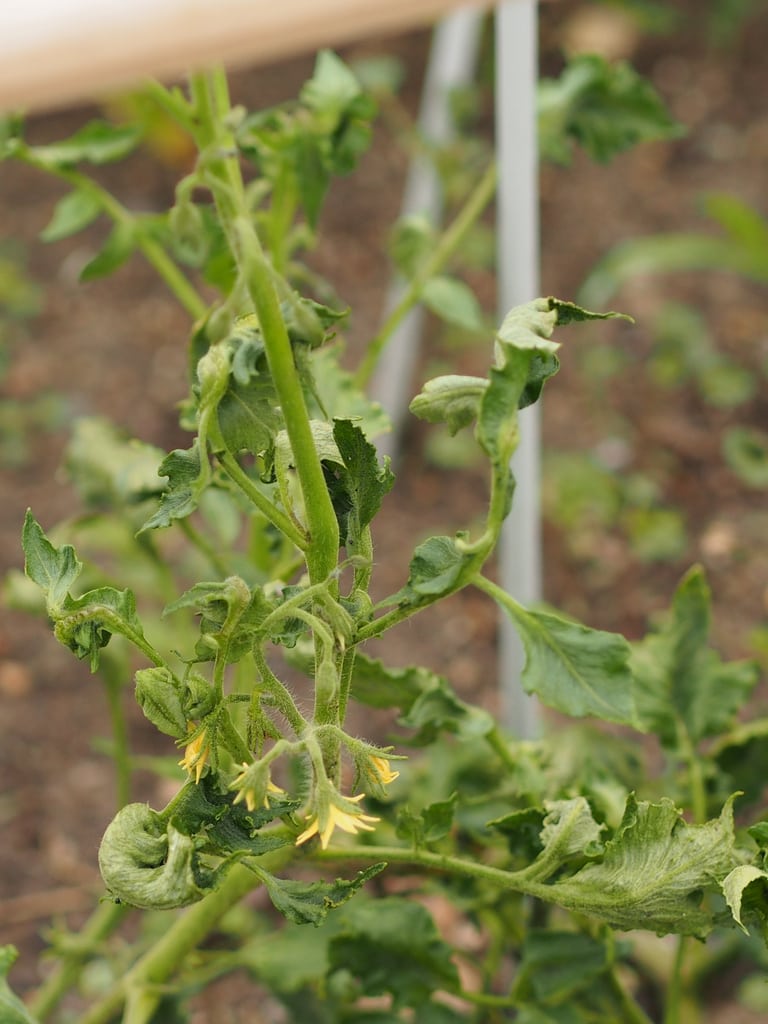
Tomato fusarium wilt can be very destructive to home gardens. It is a fungal infection that invades the roots but causes yellowing and wilting in the plant above the soil line. With severe infections you can lose a lot of tomato yield. With no way to treat fusarium wilt, prevention is the best medicine.
What is Tomato Fusarium Wilt?
Tomato plants can be susceptible to a few types of wilt, but fusarium wilt is fairly common among them. It is caused by the fungus Fusarium oxysporum. The fungus infects the plants through the rootlets and is not spread through the above-ground portions of plants.
Fusarium survives for a long time in the soil and overwinters there. The disease can be spread this way from year to year. It can also be spread through infected transplants, seeds, and tools carrying soil with the fungus in it.
Symptoms of Tomato Plants with Fusarium Wilt
A characteristic first sign of fusarium wilt is yellowing of lower leaves or leaves on one stem only. After yellowing, stems and leaves begin to wilt. These signs first appear as the fruit starts maturing.
Scraping or splitting a stem on a tomato plant affected by fusarium wilt, you will see brown vascular tissue with healthy inner tissue.
Other tomato wilt diseases cause similar symptoms but are either more uniform throughout the tomato plant or begin from top to bottom, whereas fusarium wilt yellowing begins at the bottom of the plant and may be patchy.
Preventing Fusarium Wilt on Tomatoes
Treating fusarium wilt of tomatoes is not possible. Affected branches or entire plants can only be destroyed, as they will die eventually. Prevention is the only way to avoid the damage of fusarium wilt in your tomato garden. Start with varieties that resist the disease.
Also, avoid planting tomatoes in the same spot year after year. The fungus persists in the soil for a long time.
Make sure that the soil drains well where you plant tomatoes to deter fungal growth. Use raised beds, if necessary. If you have had issues with fusarium wilt in the past, or if you just grow a lot of tomatoes, practice good garden tool hygiene, sanitizing them between jobs.
It also helps to keep plants healthy and thriving, and especially free of root knot nematode infestations, so that they can resist any disease present in the soil.
Tomato fusarium wilt can be very destructive to home gardens. It is a fungal infection that invades the roots but causes yellowing and wilting in the plant above the soil line. With severe infections you can lose a lot of tomato yield. With no way to treat fusarium wilt, prevention is the best medicine.
What is Tomato Fusarium Wilt?
Tomato plants can be susceptible to a few types of wilt, but fusarium wilt is fairly common among them. It is caused by the fungus Fusarium oxysporum. The fungus infects the plants through the rootlets and is not spread through the above-ground portions of plants.
Fusarium survives for a long time in the soil and overwinters there. The disease can be spread this way from year to year. It can also be spread through infected transplants, seeds, and tools carrying soil with the fungus in it.
Symptoms of Tomato Plants with Fusarium Wilt
A characteristic first sign of fusarium wilt is yellowing of lower leaves or leaves on one stem only. After yellowing, stems and leaves begin to wilt. These signs first appear as the fruit starts maturing.
Scraping or splitting a stem on a tomato plant affected by fusarium wilt, you will see brown vascular tissue with healthy inner tissue.
Other tomato wilt diseases cause similar symptoms but are either more uniform throughout the tomato plant or begin from top to bottom, whereas fusarium wilt yellowing begins at the bottom of the plant and may be patchy.
Preventing Fusarium Wilt on Tomatoes
Treating fusarium wilt of tomatoes is not possible. Affected branches or entire plants can only be destroyed, as they will die eventually. Prevention is the only way to avoid the damage of fusarium wilt in your tomato garden. Start with varieties that resist the disease.
Also, avoid planting tomatoes in the same spot year after year. The fungus persists in the soil for a long time.
Make sure that the soil drains well where you plant tomatoes to deter fungal growth. Use raised beds, if necessary. If you have had issues with fusarium wilt in the past, or if you just grow a lot of tomatoes, practice good garden tool hygiene, sanitizing them between jobs.
It also helps to keep plants healthy and thriving, and especially free of root knot nematode infestations, so that they can resist any disease present in the soil.
